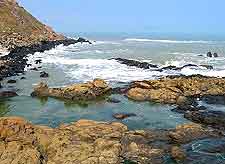Xiamen History Facts and Timeline
(Xiamen, Fujian, China)

Its location just across the strait from Taiwan has ensured that Xiamen has been seen as a strategic city worth fighting for throughout its history. As one of the original Special Economic Zones in the 19th century, Xiamen has had a long history of trade and commerce.
Today, its Fujian cultural roots have made it dear to the vast Chinese diaspora, who live abroad and continue to send back money and business to support the city's ever-growing environment of business, education and culture.
A Port Open to Foreign Trade
Although the history of Xiamen had been written for centuries before the Song Dynasty (960 to 1279 AD) came into power, it was the Song who put this port town on the modern map. By opening a sea port that was accessible to foreign traders, the Song set a precedent that would shape the future of the city for centuries to come.
The Ming also kept a strong presence in Xiamen in the 1300s, mainly after building a large fortress on the coast, which was designed to ward off pirates. The Manchu fought a series of battles with the Ming at the end of their era, in the 1600s.
Once the Qing established themselves at the next dynasty, Xiamen settled back into business as a port city. It remained China's main port for exporting tea throughout the 19th century, and the local Hokkien dialect contributed to many of the European terms Westerners adopted for Chinese products at this time.
The Opium Wars
Britain captured Xiamen in 1841 during the Battle of Amoy, a major breakthrough in the First Opium War (1839 to 1842) between Britain and China. When the Treaty of Nanking was ratified in 1842, the history of Xiamen once again looked towards global trade, as the port was named one of the five treaty ports that were open to foreign trade as a result of China losing the war.
Western Influences
Once Xiamen was opened to foreign trade, it began to experience the influence of the Westerners who came to do business here, as well as the missionaries who came here in search of people to convert. European settlements sprang up on the neighbouring island of Gulangyu, and even today Gulangyu is known for its European architecture and Western inclinations, such as piano playing and team sports.
Fujian Diaspora
When the British captured the city during the Opium Wars, hundreds of thousands of locals from the Fujian culture left to make homes elsewhere. During the 19th and early 20th centuries, they spread throughout Taiwan and South-East Asia, taking their Hokkien culture and language with them. This sizeable diaspora continues to support Xiamen today and keeps the city connected to the global community.
Lost in the Ravages of War
From 1938 to 1945, the Japanese occupied Xiamen and neighbouring Taiwan. The occupation ended when Japan was defeated by the Allies and China's Communist Party took the reins of the nation. When the Kuomintang, under their leader Chiang Kai-shek, fled to Taiwan with most of China's treasures, the city was deemed as too dangerous to support. For years after, the city was lost to history as a backwater where nothing happened.
Only in the 1980s, after some form of reconciliation with Taiwan was established, did the Chinese government decide to reinvest in Xiamen. Thanks to the current peaceful climate between Taiwan and mainland China, Xiamen is a thriving port city once again. It enjoys solid economic trade with Taiwanese businessmen and is often touted as one of China's most livable cities.
 Its location just across the strait from Taiwan has ensured that Xiamen has been seen as a strategic city worth fighting for throughout its history. As one of the original Special Economic Zones in the 19th century, Xiamen has had a long history of trade and commerce.
Its location just across the strait from Taiwan has ensured that Xiamen has been seen as a strategic city worth fighting for throughout its history. As one of the original Special Economic Zones in the 19th century, Xiamen has had a long history of trade and commerce.